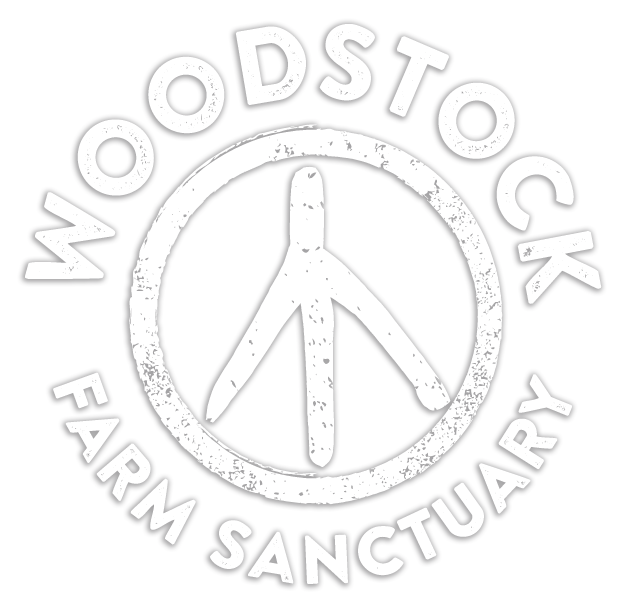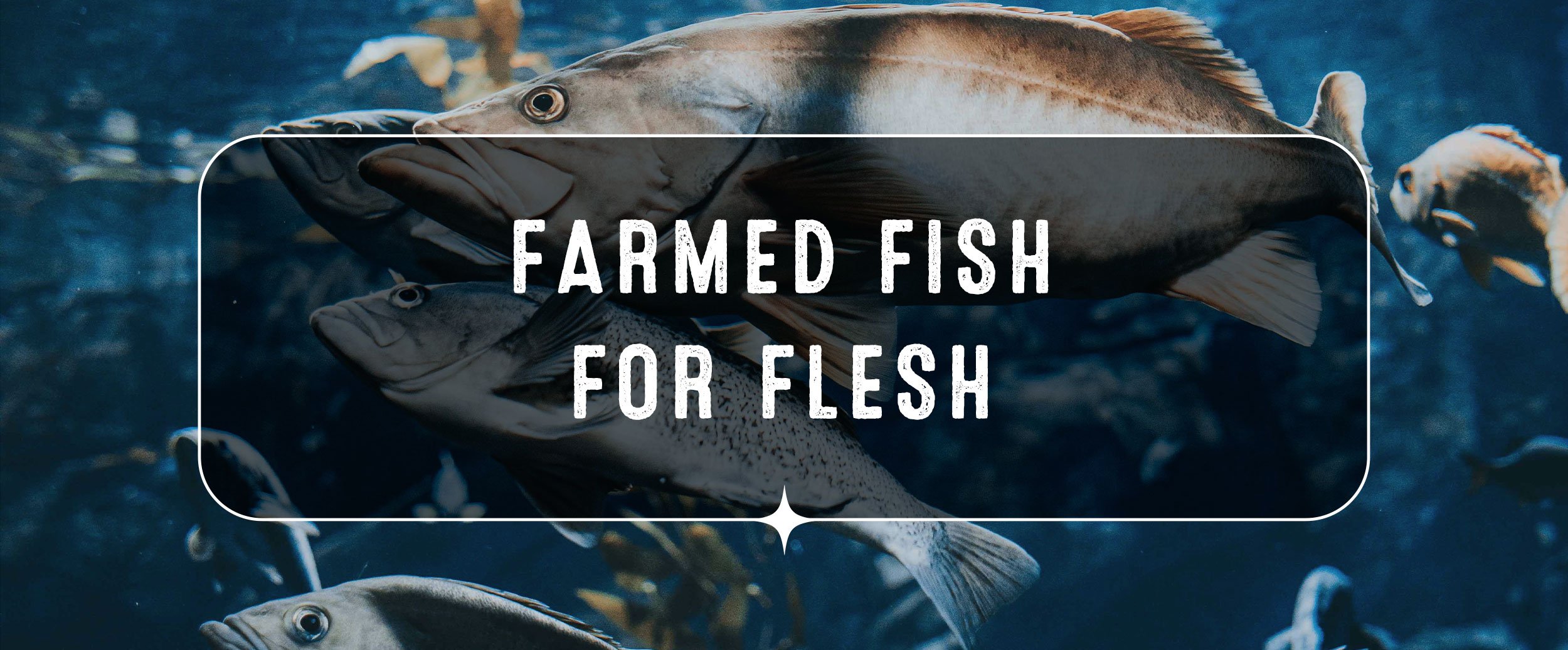THE IMPACT ON ANIMALS
Animal agriculture exploits, harms, and kills billions of animals every year for human consumption. Bred only to exist within farming, farmed animals lead lives of misery, from the moment they are born to when they are killed. Their babies are taken from them and they are not treated as individuals but just as products. Every day, millions of these special, beautiful animals are separated from their families, mutilated, kept in confinement, and killed as part of routine farming practices.
We don’t have rescued fish at the Sanctuary but it’s very important that you don’t replace other animals in your diet with fish. Fish are also farmed just like other animals in horrific conditions and fishing industries are damaging to oceans and driving fish into extinction. Please visit seaspiracy.org for information about fish and why boycotting the fishing industry including fish farms is so important.
Modern day chickens have been bred to lay hundreds of eggs a year; their ancestors would lay 12-20 eggs. It was just a natural part of their reproductive cycle. Their bodies have been manipulated to lay an egg nearly every day and they are killed before age three when they no longer lay as many eggs. No egg farm provides medical care and lifelong care for hens.
When eggs are fertilized to replace the hens who are being killed with other hens, one out of every two eggs is born a male chick who will grow into a rooster. As a rooster can’t lay eggs and won’t grow big enough to be sold for his flesh, he’s killed when he is a day old. For more information and to visit our (non-graphic) campaign about chickens, visit ConsidertheEgg.org
Several residents at the Sanctuary are hens who escaped from “live kill” markets where they were sent after egg farms decided they weren’t laying enough eggs to keep them alive any longer. They are traumatized and scared but they often fight back and some escape.
Chickens who are most commonly bred for their flesh are called Cornish Crosses or “Cornish.” They have selectively bred over thousands of generations to be very large so that they can be killed when just seven weeks old. Most of them will never meet their mothers and are kept in large sheds or warehouses until they are sent to be killed. When they are seven weeks old they are still babies—still making the cheeping sound they would use to communicate to their mom while still in the egg and while a chick. They are too little to cluck or crow when they are piled in crates, often breaking legs and necks in transit, without food or water to be sent to slaughterhouses. There are no laws governing how chickens can be killed so any method is legal.
When they are rescued, these Cornish chickens need special care their entire lives to stay healthy. The way that they have been bred means that they become large at very young ages and develop many health issues. They are also among the most gentle and funny animals at the Sanctuary – many people have Cornish chickens as house companions because they are known for their gregarious personalities and ability to live with humans, dogs, and cats.
As they are mammals, cows must have babies in order to lactate. Cow’s milk is breast milk meant for their babies. Cows who live on dairy farms of any size are forcibly impregnated and their babies are taken away from them so that they can be milked and that milk can be sold. Those babies are either sold to other farms if they are girls or if they are boys they are usually killed outright, allowed to die, or sold at auctions for cheap meat and will be dead by the time they are a few months old. When the adult female dairy cow is no longer as able to get pregnant (this is by early middle age), she is usually sold for cheap meat. This is commonly by the age of 4-6 whereas a rescued cow can live to be 20 with proper care at a sanctuary.
When we rescue cows from dairy farms, they are usually scared or not trusting of humans at first. And they really love being around rescued calves after they had their babies taken from them again and again.
For more information and to visit our (non-graphic) campaign about cows, visit MeetJo.org
Cows, like all animal who are farmed for their flesh, are killed when they are very young. The breeds used for flesh production are larger than those used for milk production so they get very large quickly—even with how quickly they grow, they are killed when they are not full grown. They are treated just as commodities – bred for size, separated from their families, and forced on and off of trucks and into slaughterhouses.
Some of the cow residents at the Sanctuary have run from slaughterhouses or jumped from transport trucks on the way to auction and slaughterhouses. Cows know what is happening to them and they try to escape – they fight for their lives in terror.
The most commonly farmed turkey is the Broad Breasted White Turkey. They have been bred over thousands of generations by the industry to be very large so that they can be killed when they are just a few months old. The turkey bodies you see in supermarket freezers are babies. At the bigger industrialized farms, their beaks are seared at the tip and the tips of their toes are cut off so that they can be kept in warehouses without biting or scratching each other. These turkeys will never meet their mothers who are being kept to be forcibly impregnated by humans and again and again until they are killed.
When you rescue turkeys, you have to take fight against how the industry has bred them. They require a lot of medical care and specialized diets. But while they are killed at just a few months at a farming facility, at a sanctuary turkeys can live to be over 10 years old! They are often the favorites of our visitors as they are very people oriented and curious.
Goats live short lives on farming facilities. They are often dehorned and castrated which is done without any pain relief when they are babies so that they can be kept in small areas with other goats. Like every animal who is sent to the slaughterhouse or to auction, they often fight back and try and escape. Although they are killed when they are very young in farming, goats with proper care can live to be 15.
There are several goats at the Sanctuary who ran from markets or slaughterhouses and were found by kind people. They arrive usually fearful of humans and some will be never be comfortable around strangers. They are extremely social and many enjoy meeting new people and visitors to the Sanctuary.
Oftentimes people have fallen for the marketing of goat dairy farming being more humane than cow dairy farming. This is not the case. Goats who are kept at goat dairy facilities also have their babies taken from them; the girls are kept to replace their mothers or are sold, whereas the boys are sent to auction or slaughterhouses as babies. Goat mothers are kept until they are no longer as able to get pregnant easily and then they are sent to auction for cheap meat. They are not provided medical care like you would your companion dog and cat – they are being used for their bodies and are discarded once they are no longer profitable.
There are several goat families at the Sanctuary – this happens when the mothers were rescued when they were pregnant and gave birth to babies in safety. Goats are really amazing mothers who are protective and kind to their children. Even with their children are adults, they usually want to stay close to their mothers and live together. You can find senior mother goats with their adult children cuddling in the goat barns at night.
Ducks who are farmed for their flesh are often kept in terrible conditions – lack of space, food intended just to make them large quickly, and nothing that brings a duck peace or happiness. The most commonly bred for flesh breed is the Pekin Duck who has been bred over thousands of generations to become very large as a baby. Pekins are sent to auction or to the slaughterhouse when they are very young. Ducks are also used for foie gras which requires a farming practice where ducks are force fed until their liver becomes diseased.
Ducks are also bred for their feathers for “down” comforters and clothes. These feathers are either collected after the duck has been killed for meat but some production facilities make more profit off of the ducks by pulling out their feathers while they are being farmed for flesh or foie gras or being used for breeding. It’s incredibly painful and traumatic.
The duck pond at the Sanctuary is full of characters. Ducks are incredibly social and have friendships and sometimes lifelong partners. We have had duck pairs who are together for over a decade.
Sheep are brutalized in farming. They are bred for their flesh and are commonly killed and eaten as lambs. Obviously lambs are just baby sheep – they are just a few months old when they are killed. Older sheep are also killed for their flesh but all are dead in farming by a few years old. They are herd animals who don’t have many protections against predators and the common practices of farming are terrifying to them.
Wool production also harms sheep. They’ve been bred through human selection to not shed their wool naturally. So when you breed sheep, they now have to be sheared. This process if done for profit is usually really scary for sheep – they get cut, thrown around, and often lose parts of their tails or ears to the shears. Then after they are a few years old, their fleece isn’t as thick anymore so they are usually sent to auction to be sold as cheap meat.
Sheep at the Sanctuary are so kind and gentle. Some of them will never like or trust humans. But those that are willing to trust, will come up and put their heads against you. They are very communal and look out for each other—developing lifelong friendships.
Rabbits are commonly farmed for both their flesh and their fur. Those bred to be large are kept in hutches before being killed or sold to markets or auctions. You can find rabbits crammed into crates at “live kill” markets throughout New York City and other large cities. These gentle, timid animals are terrified by the smells and sounds surrounding them before they are killed. Some rabbits are bred for fur like the Angora breed. Unlike some fur production where animals are killed and their skin is removed to be sold with the fur, rabbits have the fur pulled from their bodies while they are still alive. This happens again and again. Usually they are killed when they are no longer young as their fur isn’t as thick.
Rabbits at the Sanctuary come from farms, markets, labs, and are found abandoned. They are very particular about their friends so we have to have many different areas for them so they can just live with other rabbits whom they like. They can be very people friendly and are very curious.












